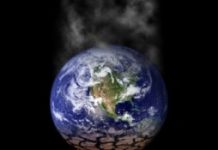This article first appeared in Liberal Nation Rising.
It’s cold in the Northeast.
The wind, although not as strong as it was three days ago, bites like January. After Friday’s nor’easter dumped snow and rain and toppled trees, resulting in thousands still without power, we are expecting another major storm this week.
Two weeks ago, it was 75 degrees.
A sunless arctic is experiencing a heat wave. Studies show spring is arriving 16 days earlier than it did ten years ago.
Temperatures in Siberia increased 35 degrees celsius above historical averages last month as average daily Arctic temperatures this year have been up to 20 celsius–that’s 68 degrees Fahrenheit–higher than average.
The average February high for northern Greenland is supposed to be around -20 degrees Fahrenheit. But it has already had 61 hours above freezing this year, more than three times as many hours as previous years. At Cape Morris Jesup, the world’s most northerly land weather station at Greenland’s northern tip, recent temperatures have been 63 degrees Fahrenheit warmer than average–warmer than London, England and Zurich, Switzerland, thousands of miles south. Putting that into perspective, it’s equivalent to a 112-degree day in Denver in February.
While arctic sea ice levels are at record lows for this time of year, exceptional snow and wind last week forced airports in Scotland, Switzerland, and France to close.
Yes, aberrant weather happens, but this is not normal. It is so abnormal, in fact, scientists are being forced to reconsider even their most dire predictions about climate change.
About the “crazy,” “weird” weather occurring more frequently, Ruth Mottram of the Danish Meteorological Institute, said:
“Spikes in temperature are part of the normal weather patterns – what has been unusual about this event is that it has persisted for so long and that it has been so warm. Going back to the late 1950s at least we have never seen such high temperatures in the high Arctic.”
Michael Mann, director of the Earth System Science Center at Pennsylvania State University, had this to say:
“This is an anomaly among anomalies. It is far enough outside the historical range that it is worrying – it is a suggestion that there are further surprises in store as we continue to poke the angry beast that is our climate. The Arctic has always been regarded as a bellwether because of the vicious circle that amplify human-caused warming in that particular region. And it is sending out a clear warning.”
Scientists are attributing the rapid weather fluctuations to inconsistencies in the polar vortex, a large low pressure area of cold air surrounding both poles, dependent upon the temperature differential between the Arctic and mid-latitudes. It’s supposed to weaken in summer and strengthen in winter. As it fluctuates, temperatures spike and plummet rapidly–never more so than this year because the Arctic is warming faster than anywhere else on the planet.
According to Nasa, Arctic sea ice is now declining 13.2% per decade, producing more open water and higher temperatures.
Lead scientist of Berkeley Earth, Robert Rohde, said:
“In 50 years of Arctic reconstructions, the current warming event is both the most intense and one of the longest-lived warming events ever observed during winter.”
Rohde expects this continue.
He said:
“As we rapidly warm the Arctic, we can expect that future years will bring us even more examples of unprecedented weather.”
And it will make life on this planet increasingly challenging. With a changing climate comes a changing environment that displaces millions of people, creates food shortages, and threatens governments’ stability.
Meteorologist and founder of the website Climate Dissemination, Jesper Theilgaard, said:
“No doubt these warming events bring trouble to the people and the nature. Shifting rain and snow – melt and frost make the surface icy and therefore difficult for animals to find anything to eat. Living conditions in such shifting weather types are very difficult.”
Dr. Mann commented:
“This is too short-term an excursion to say whether or not it changes the overall projections for Arctic warming. But it suggests that we may be underestimating the tendency for short-term extreme warming events in the Arctic. And those initial warming events can trigger even greater warming because of the ‘feedback loops’ associated with the melting of ice and the potential release of methane (a very strong greenhouse gas).”
This comes at a time when The United Nations warns the concentration of carbon dioxide in the atmosphere increased last year at record pace, reaching a level not seen on Earth since the Pliocene era three to five million years ago.
And yet, in January Donald Trump dropped climate change from a list of global threats.
Environmental Protection Agency (EPA) director Scott Pruitt was personally involved in purging information from the EPA website shortly after assuming his position last year, and ordered staff to refrain from using the phrases “climate change,” “emissions reduction” or “Paris Agreement” in written memos, briefings, or other written communication the same day President Donald Trump signed an executive order at EPA headquarters to undo most of President Obama’s climate regulatory initiatives.
There is no time left.
This is the zero hour.
Image credit: National Oceanic Atmospheric Administration (NOAA)




